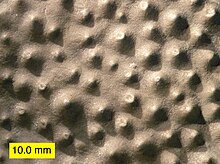
Back Stromatoporatalar Azerbaijani Страматапараідэі Byelorussian Estromatoporoïdeus Catalan Stromatopory Czech Stromatoporen German Stromatoporida Spanish Stromatoporoidea French Stromatoporen ID სტრომატოპორები Georgian Stromatoporas Latvian/Lettish
| Stromatoporoidea Temporal range: Most post-Devonian identifications are likely unrelated to the main Paleozoic radiation
| |
|---|---|

| |
| Top view of a stromatoporoid with prominent mamelons. From the Columbus Limestone (Middle Devonian) of Ohio. | |
| Scientific classification | |
| Domain: | Eukaryota |
| Kingdom: | Animalia |
| Phylum: | Porifera |
| Class: | †Stromatoporoidea Nicholson & Murie, 1878 |
Stromatoporoidea is an extinct clade of sea sponges common in the fossil record from the Middle Ordovician to the Late Devonian.[1] They can be characterized by their densely layered calcite skeletons lacking spicules. Stromatoporoids were among the most abundant and important reef-builders of their time, living close together in flat biostromes or elevated bioherms on soft tropical carbonate platforms.
Externally, some species have raised bumps (mamelons) and star-shaped crevices (astrorhizae), which together help vent exhalant water away from the living surface. Internally, stromatoporoids have a mesh-like skeletal system combining extensive horizontal layers (laminae), vertical rods (pillars), and boxy spaces (galleries), along with other features. The most common growth forms range from laminar (flattened) to domical (dome-shaped). Spheroidal, finger-like, or tree-like species also occur, though they are rare in most environments.
Stromatoporoids competed and coexisted with other reef-builders such as tabulate and rugose corals. Some stromatoporoid species are useful as environmental proxies, since their form and distribution can help approximate the depositional environment of sedimentary strata.[2] They hosted a diverse fauna of encrusting symbionts both within and outside their skeletons.[3][4][5] Some studies have argued that stromatoporoids were mixotrophs (engaged in a mutualistic relationship with photosynthetic algae), similar to modern scleractinian corals. Though this hypothesis is plausible, circumstantial evidence is inconclusive.
Prior to the 1970s, stromatoporoids were most frequently equated with colonial hydrozoans in the phylum Cnidaria (which also includes corals, sea anemones, and jellyfish). They are now classified as sponges in the phylum Porifera, based on their similarity to modern sclerosponges. True Paleozoic stromatoporoids (sensu stricto) encompass seven orders. Two or three of these orders appeared in the Ordovician while the rest evolved in the Silurian. They rediversified subsequent to mass extinctions at the end of the Ordovician and Silurian, but a more profound decline began in the Late Devonian. With a few putative exceptions, they apparently died out during the Hangenberg event at the end of the Devonian.[6] A number of hypercalcified Mesozoic sponges have been classified as stromatoporoids, but they are likely unrelated to the Paleozoic radiation, thus making 'stromatoporoids' (in the broad sense) a polyphyletic group if they are included.
- ^ Stock, C.W. 2001, Stromatoporoidea, 1926–2000: Journal of Paleontology, v. 75, p. 1079–1089.
- ^ Da Silva, A. C.; Kershaw, S.; Boulvain, F. (2011). "Stromatoporoid palaeoecology in the Frasnian (Upper Devonian) Belgian platform, and its applications in interpretation of carbonate platform environments". Palaeontology. 54 (4): 1–23. Bibcode:2011Palgy..54..883D. doi:10.1111/j.1475-4983.2011.01037.x. S2CID 128455331.
- ^ Vinn, O; Mõtus, M.-A. (2014). "Endobiotic Rugosan Symbionts in Stromatoporoids from the Sheinwoodian (Silurian) of Baltica". PLOS ONE. 9 (2): 9(2): e90197. Bibcode:2014PLoSO...990197V. doi:10.1371/journal.pone.0090197. PMC 3934990. PMID 24587277.
- ^ Vinn, O.; Wilson, M.A.; Mõtus, M.-A. (2014). "Symbiotic endobiont biofacies in the Silurian of Baltica". Palaeogeography, Palaeoclimatology, Palaeoecology. 404: 24–29. Bibcode:2014PPP...404...24V. doi:10.1016/j.palaeo.2014.03.041. Retrieved 2014-06-11.
- ^ Vinn, O; Wilson, M.A.; Toom, U.; Mõtus, M.-A. (2015). "Earliest known rugosan-stromatoporoid symbiosis from the Llandovery of Estonia (Baltica)". Palaeogeography, Palaeoclimatology, Palaeoecology. 31: 1–5. Bibcode:2015PPP...431....1V. doi:10.1016/j.palaeo.2015.04.023. Retrieved 2015-06-18.
- ^ Kaiser, Sandra Isabella; Aretz, Markus; Becker, Ralph Thomas (2016-01-01). "The global Hangenberg Crisis (Devonian–Carboniferous transition): review of a first-order mass extinction". Geological Society, London, Special Publications. 423 (1): 387–437. Bibcode:2016GSLSP.423..387K. doi:10.1144/SP423.9. ISSN 0305-8719. S2CID 131270834.
© MMXXIII Rich X Search. We shall prevail. All rights reserved. Rich X Search